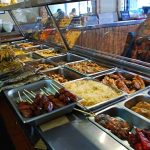
Carinderia is a local eatery selling and serving affordable viands for the masses. It's also known as a "turo-turo" wherein customers literally point what they want to eat. If your house is located in a busy area or surrounded by a lot of office buildings and schools, then putting up a
carinderia business is a wise choice. You can start your
business right in your own home with a small capital investment!
 Things to Consider in Putting up a Carinderia Business: Capital:
Things to Consider in Putting up a Carinderia Business: Capital: You need about P15,000 to open a small
carinderia or food kiosk. The
money will go to two weeks' worth of inventory of food and ingredients, equipment and utensils, space rentals, and barangay permit fees. You may need a lower amount if you will do business in your own backyard or front yard (deduct P1,500 to P2,000 from the original estimate if this is the case) and if you will use your own existing kitchen utensils (deduct their brand-new cost). Assuming an income of P600 daily six days a week, you can expect to recover your investment by the second month.
Materials: You will need a space to accommodate your kitchen equipment and one to two small tables for your customers; a stove with an LPG tank (or charcoal supply if you prefer to use a charcoal stove); and cookware, plates, spoons and forks, and other utensils.
Workforce: You need not hire staff to get started in this business. However, when you feel it's time to expand or offer a wider variety of dishes, you will likely need one or two staff to serve customers, wash dishes, and clean up the place.
Process: To do this business, you must have determination and a real interest in cooking. According to Rene Jose Macatangay, a carinderia owner-operator for 11 years now, he would wake up as early as 2:00 or 3:00 a.m. to get the freshest produce when he does his marketing for food ingredients. Promptly at 4:00 a.m., he would be back at his food kiosk to do the cooking.
Location: Finding a good location for your food kiosk is extremely important. A place very near or easily accessible to your target customers, say taxi or tricycle drivers, would be ideal. It's also advisable to check with your barangay council if a permit is needed for a small carinderia.
Menu: Decide how many meals you will serve for the day and prepare a menu plan for at least a week. Some carinderia owners stick to a fixed menu plan particularly if they have already established best-selling dishes. In the case of Macatangay, however, he only serves merienda (snacks) and lunch. He opens at 10:00 a.m. and closes by 4:00 or 5:00 p.m. He regularly serves goto and lugaw (both
rice porridge snacks) and
tokwa (
soybean cake). Although he changes his lunch menu every day, he has standard fare for particular days, like ginisang munggo (stewed mung beans) every Friday.
Price: Make your
pricing reasonable and within the reach of your target market. Macatangay says he keeps his prices low to maintain the loyalty of his regular customers.
Marketing: Word-of-mouth
advertising is your best promotional tool for this
type of business. Satisfied customers will talk about your carinderia and recommend it to their friends who happen to be in the vicinity. And for Macatangay, it is a source of great satisfaction to see his loyal customers come back every day for his food fare. With tasty, clean and affordable food with variety; and good marketing and location, you're
carinderia business will surely be successful. Source:
entrepreneur.com.ph
Source: Business Diary Philippines



0 Comments